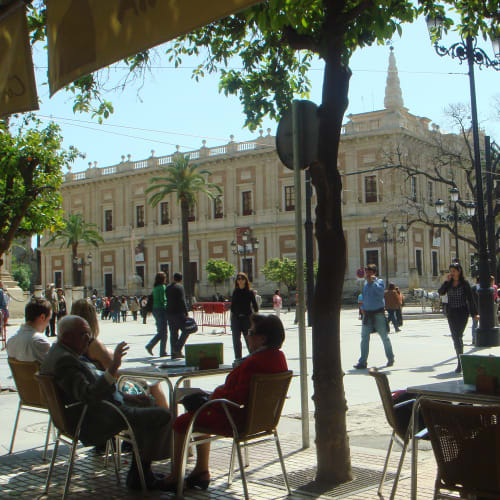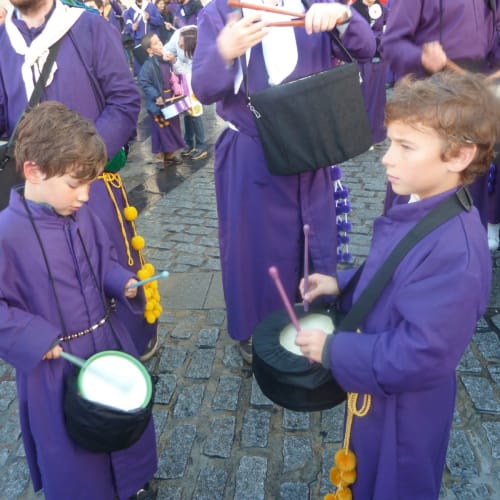Three Kings Sale - Up to 40% Off! Shop Sale
Letters from Valencia
Don Harris | October 2012




Recently I was looking though some old letters and unexpectedly found a note to my wife that I sent from Spain in 1965! It was exciting to relive my first experiences in Spain and striking to see how my first impressions continue to be confirmed, even now, almost 50 years later!
Since the 1960s, my family and I have enjoyed spending time with hundreds of Spanish families, and we even lived for two years in one of the sherry towns of Andalucía. But oddly enough my love for Spain had roots in my childhood – long before I had even met a Spaniard.

I was a "latchkey kid" who, for several years, was alone at home after my school day ended. I passed the time listening to jazz and browsing magazines and art books (there was no television). I was particularly drawn to a beautiful book devoted to the pictures of the mystical Spanish painter, El Greco. His depiction of the spiritual dimension of humanity and the emotional depth of his vision resonated deeply with me.
However, it was not until sixteen years later that I made a firsthand connection with the people and culture of Spain. In 1965, they were still recovering from an enormously bloody civil war, and years of hunger and deprivation. Yet despite this, I observed their strong family ties and their love of children. I found it a joy to be among them.
I was a newly commissioned Navy chaplain and Ruth and I were newlyweds planning to settle in Washington, DC for a two or three year Navy tour. However, at the last minute I was ordered to a destroyer squadron in Virginia to replace an ailing chaplain. It was quite a shock; Ruth staying alone in an unfamiliar city, and I joining the crew of my first Navy ship for a six-month cruise after only eight weeks of marriage.
While deployed, my communication with Ruth was the old-fashioned way – by U.S. Mail. This was long before the age of instant communication and virtually free telephone calls. The other day I came across the first letter of the cruise, in which I told Ruth of my enthusiasm for Spain and her people. It was an amazingly detailed letter (I loved writing even 50 years ago!) and provided a peek into the past. I will share some of it with you below.
That March, after a North Atlantic crossing, the four ships of the destroyer division nested along the pier in Valencia. Lucky for us it was during the week of Las Fallas – an annual extravaganza of food, drink, thundering fireworks and gigantic homemade satirical images that the creators would set ablaze on the final day, on the feast of San José. It is an astonishingly noisy event. The young sailors were delighted!
One day at a tapas bar in port, my thoughts went back to my childhood. I thought to myself, "Here I am in Spain; this is my chance to meet El Greco face to face, so to speak." So I left the Las Fallas festivities and caught the Talgo train to Madrid and the Prado Museum – it was only a two-hour train ride away. I was not at all prepared for what happened next, it was a life changing experience. I wrote to Ruth back home:
When I entered the Prado Museum and encountered room after room filled with El Greco’s work, I was overwhelmed with emotion and I could not tear myself away from his paintings. They were truly a religious experience.
I was so entranced or enmeshed in this experience that the only possible thing to do was to drive out to Toledo to see more of his work, the town he lived in, the cathedral he worshiped in and the whole milieu, which produced such a profound man.
So my shipmate and I caught a taxi to Toledo. It was an amazing sight. I wrote to Ruth:
It was just as {El Greco} had painted it and was easily 400 years behind times. Virtually no cars could be seen, little electricity, no heating, no English spoken, a big central plaza stocked with appropriate Castilian peasant-types, narrow winding dirt roads pounded down by centuries of use weaving between the very close brick houses and gates.
For centuries, Toledo was the political and intellectual heart of Spain. It is located on a series of hills and encircled by an immense wall. The Romans occupied it until 190 AD when it became the seat of the Visigoth kingdoms. About two centuries later, the Moors captured Toledo and ruled it for 370 years until the Christians of the Reconquest gained sovereignty in 1082. Toledo is the soul of Spain, and I wrote to my wife with great enthusiasm:
The whole city is a huge chalky hill with buildings a uniform ochre color. The Cathedral is the most moving in all Europe as far as I am concerned. It is full of treasures donated by most of the top figures in history. The woodwork is exquisite in its carving and design, as well as its embodiment of Spanish mysticism. The reredos behind the altar soars 50 feet or more and is an intricate woodcarving portraying the life of Christ in florid Spanish Gothic style. It was so overwhelming that I literally was brought to my knees.
I still see this Spain today, even as we move farther into the 21st century. The mystical spirit of El Greco, whom I met as a child, is what makes Toledo holy for me. The locus of Spain’s soul lies among the churches, synagogues and mosques built by her inhabitants over hundreds of years. Most of all, I sense this core value among my Spanish friends today. It is a spirituality, which greets all people as sacred, of equal value.
This April, Ruth and I returned to Toledo. This time, amidst the hustle and bustle of hundreds of tourists and locals, we encountered a group of 80 choirboys who had come from Japan to give a sacred concert in the cathedral. We joined them and hundreds of other faithful the next morning as we processed with palm fronds along the cobble-stoned streets that surround the cathedral. We were among people who had gathered from all over Spain to celebrate El Dia de Ramos, Palm Sunday. Toledo was no longer a place of winding dirt roads, but rather a quietly splendid city with the Zocodovar plaza packed with young people on Easter vacation.
Not in Toledo alone, but in so many cities in Spain, it is not the buildings, but the children, the parents, the grandparents, the people of all generations who continue to maintain the traditions, unaffected by cycles of prosperity and hardship. I have great faith in the Spanish people – their foundation is strong. Their loving families, cherished children and spiritual roots remain their anchor. From the first day I stepped ashore so many years ago, I felt at home. I am truly grateful to the culture and people who have had such a profound influence on my life, and for the opportunity to reciprocate through La Tienda.
Atentamente,
Don

